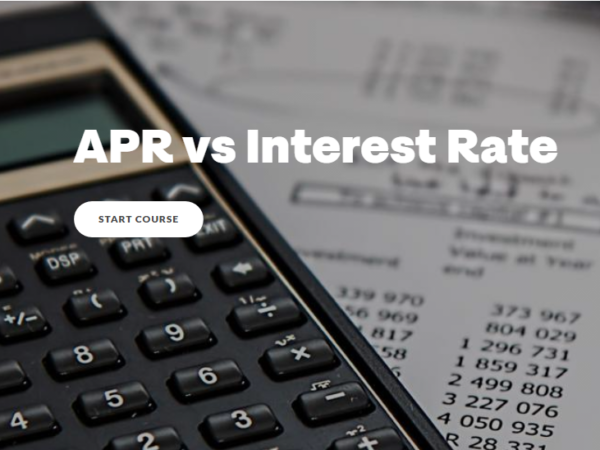Small Business Interest Rates: Interest Rate Comparison
Learn about interest rates for business financing, including cash flow loans, merchant cash advances, microloans and Peer-to-Peer loans.

In part three of our series about small business interest rates, we looked at the difference between a monthly interest rate and an Annual Percentage Rate (APR). In this section, we’ll explore the different types of loans available to small business owners.
When it comes to small business loans, traditional banks aren’t always the best bet. They allow businesses to borrow large amounts of money at the lowest interest rates, but small business owners often need to borrow smaller sums. This, combined with the fact that small businesses are typically seen as a higher risk, means that borrowers don’t easily qualify for traditional bank loans. The application process can also be prohibitive, between the volume of paperwork, the required collateral, and the long wait times to be approved and to receive funding.
The good news is that there are other ways to finance a business. There are lenders who are willing to serve small business owners by approving small loan amounts to high-risk borrowers. These loan products have both advantages and disadvantages that should be carefully considered before making a choice.
Here are some popular ways small businesses can get funding, plus the risks and rewards of each loan type.
Cash Flow Loans
Cash flow loans allow business owners to borrow money against future profits. The loan is paid back from a percentage of your sales every day or several days a week until the loan is paid off; or you might pay a fixed monthly amount over the length of a term.
The Bottom Line: Fast and easy approval, but expensive.
Here are the pros and cons of Cash Flow Loans:
Pros
- You may be able to qualify for a cash flow loan with bad credit if your business has strong sales.
- The application process requires minimal paperwork.
- The decision to approve or deny your application will usually happen within 24 to 72 hours, and funds are delivered quickly.
- Depending on the lender, you may be able to borrow from $5,000 to $250,000.
Cons
- They can be expensive; since cash flow loans tend to have shorter terms, many have high APRs.
- There is no prepayment allowed, or there may be heavy prepayment penalties.
- They are considered a somewhat risky form of financing; borrowers have reportedly been bankrupted when they can’t keep up with cash flow loan repayment.
Merchant Cash Advances
Merchant cash advances are similar to cash flow loans in that you’re loaned money in exchange for future business income. In the case of a merchant cash advance, the income in question is specifically a percentage of your business’s credit and debit card transactions.
A merchant cash advance company might link to your bank account to collect repayment at regular intervals, or they might collect a percentage of your sales directly from the processor that handles credit card transactions for your business.
Since merchant cash advances aren’t technically loans, they are unregulated and unbound by usury laws that prevent lenders from charging high fees and interest rates.
The Bottom Line: An accessible means of financing for those with bad credit, but risky.
Here are the pros and cons of Merchant Cash Advances:
Pros
- Businesses can qualify for a merchant cash advance with bad credit.
- Access to cash almost immediately after filling out a simple application.
Cons
- Merchant cash advances are one of the most expensive and therefore riskiest ways to fund your business.
- Because payments are a percentage of your sales, the more money you make, the higher your payments.
- Merchant cash advance repayments often take a significant portion of a business’s sales, which can lead to cash flow problems.
- There are no advantages for early payoff.
Microloans
A microloan is a similar product to a traditional business bank loan, except loan amounts tend to be much smaller. Microlenders typically allow business owners to borrow up to $50,000. The average microloan is $13,000. Like traditional loans, microloans are payable in equal monthly installments.
The Bottom Line: Smaller loans and a longer application process, but less risk to the borrower.
Here are the pros and cons of Microloans:
Pros
- Startups with no credit history or businesses with other risk factors can qualify for a credit- builder microloan.
- The microloan approval process often takes the business’s story into consideration, even if the business has some risk factors.
- Microlenders usually offer value-add services like education, training, help with marketing plans, and other client support.
- Microlenders’ APRs tend to be more reasonable than some alternative loan products.
Cons
- Small loan amounts can be limiting for some businesses.
- The application process tends to be thorough and somewhat time-consuming.
- Interest rates vary depending on a borrower’s credit risk. A borrower might have to do work to repair credit or strengthen cash flow in order to qualify for a lower interest rate.
- An outstanding tax lien, recent bankruptcy, or recent delinquent payment might disqualify you.
Peer-to-Peer Loans
Peer-to-Peer (P2P) loans are granted via a platform that connects borrowers with individual and institutional investors acting as lenders. P2P lending platforms charge an origination fee to borrowers and a service fee to investors. Borrowers make fixed, monthly loan payments to repay their loan plus interest to their investor.
The Bottom Line: Flexible and competitive, but a slow process.
Here are the pros and cons of Peer-to-Peer Loans:
Pros
- Depending on the platform, loans can range from $5,000 to $500,000, which suits a range of business sizes and goals.
- Interest rates tend to be competitive at the lower end of the range.
- Usually no prepayment penalties.
Cons
- It can take two weeks for loans to be funded.
- The application process tends to be thorough and somewhat time-consuming.
- Qualifications might be too stringent for some applicants. Riskier applicants might not qualify for a desirable interest rate or at all.
Small Business Loan APRs
Here is an approximate summary of APRs for each loan type.
Cash Flow Loans
30% APR to 134% APR, approximately
Merchant Cash Advances
40% APR to 350% APR, approximately
Microloans
12% APR to 18% APR, approximately
Peer-to-Peer Loans
6.68% APR to 35.97% APR, approximately
When it comes to choosing a loan type for your small business, you need to ask yourself the same question that lenders will be asking: How much risk am I willing to take on?
If you have good credit and a flexible timeline, you won’t need to accept much risk. If you need cash now and your credit isn’t great, your options are more limited. In either case, research your lender thoroughly, read all the fine print, and make sure you can fulfill your financial obligations before signing on the dotted line.









